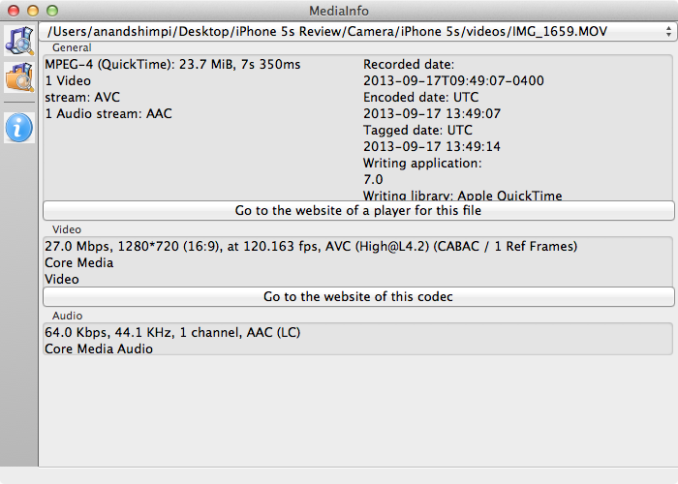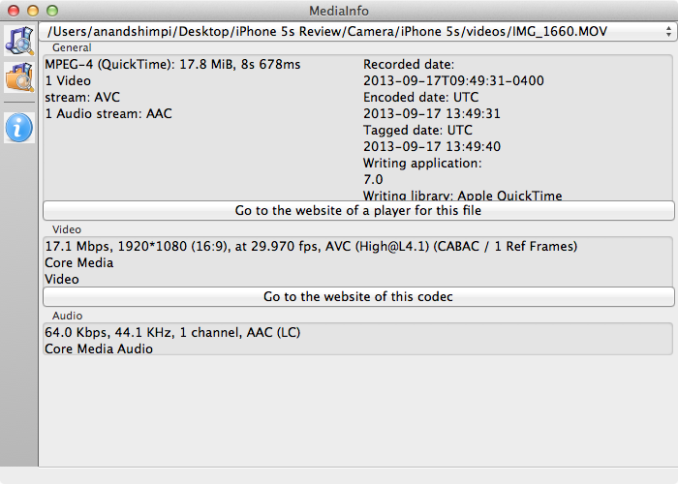The iPhone 5s Review
by Anand Lal Shimpi on September 17, 2013 9:01 PM EST- Posted in
- Smartphones
- Apple
- Mobile
- iPhone
- iPhone 5S
Video
Apple’s new H6 ISP brings with it a modernization of the video recording options for the iPhone 5s. The default video record mode is still 1080p at 30 fps, but there’s also a new 720p 120 fps “slo-mo” mode as well. In the latter, video is captured at 120 fps but optionally played back at 30 fps in order to achieve a high speed camera/slow motion effect. The result is pretty cool:
In the camera UI you can select what portions of the video you want to play back at 30 fps and what portions you want to leave at full speed. The .mov file is stored on NAND as a ~27Mbps 720p120 without any customizations, however when you share it the entire video is transcoded into a 30 fps format which preserves the slow motion effect.
The slo-mo mode is separate from the standard video recording mode, it’s the next stop on the dial in the new iOS 7 camera app. Video preview in slo-mo mode also happens at 60 fps compared to 30 fps for the standard video record and still image capture modes.
 Camera preview frame rate, toggling between slo-mo and normal modes
Camera preview frame rate, toggling between slo-mo and normal modes
Adding high speed camera modes to smartphones is a great step in my opinion and a wonderful use of increases in ISP and SoC performance. I would like to see Apple expose a 1080p60 mode as well. Technically 1080p60 does require slightly more bandwidth than 720p120, but I’d hope that Apple targeted both in the design of H6 and simply chose to expose 720p120 as it’s an easier feature to market.
Standard 1080p30 recording is also available:













464 Comments
View All Comments
flyingpants1 - Wednesday, September 18, 2013 - link
Sorry, no. As much as I hate Apple products.. Apple is killing it with amazing battery life, some of the best IPC, possibly best thermals (and therefore lowest profile) and the BEST performance, all at the same time.Whatever you said about testing multiple phones doesn't matter. It doesn't change facts.
melgross - Wednesday, September 18, 2013 - link
The Moto X hardly competes at all. What he said is true. We're talking an SoC that runs at a lower speed, often considerably slower. What Apple comes out with new iPads in October, they will increase clock speed by 15% or so, and often with more GPU cores as well, usually by 50%. We'll see what the chip can really do then. To be compared to tablets, and come ahead is pretty damning to other processor manufacturers.jeffkibuule - Wednesday, September 18, 2013 - link
When you design both hardware and software, you get optimize far more that when an OEM gets code from Google and *attempts* to get it working best on their hardware. And lets be clear, Android OEMs are clearly throwing more hardware at a software problem, when even a Windows phone with a 1.5 year old SoC in the Lumia 1020 feels far smoother and fluid that the latest Android phone.ananduser - Wednesday, September 18, 2013 - link
Simple...in the current smartphone game of leapfrog, the last one to release its flagship is the top dog. This time the A7 sports a brand new, benchmark "friendly", ARM designed ISA. Next time Exynos will have the upper hand, or Qualcomm, or nVidia.The GPU is made by Imagination not by Apple. The other manufacturers are trying to push their own solution rather than making due with a 3rd party. Technically any other manufacturer could pay Imagination for their Rogue chipset.
Good for you, really.
akdj - Wednesday, October 9, 2013 - link
"This time the A7 sports a brand new, benchmark "friendly", ARM designed ISA. Next time Exynos will have the upper hand, or Qualcomm, or nVidia."You're right---of course, as technology progresses----but the funny thing is, even the 'year old' iPhone 5 holds it's own against even the latest flagship Android devices when it comes down to graphics and browsing/energy (battery life). Apple's NOT just buying off the shelf parts from Imagination----they've hired many a chip expert/designer in house and are now not only optimizing their S/W code to the chip---they're also designing the chips architecture to their system with Imagination and in house skill sets. No other company is doing this yet...and with the new A8 instruction set---this is the best I've seen in 's' updates since the release of the 3GS.
It's a strong move by Apple, these past few years---to apply their own instruction and low level programming as well as SoC design, match up to iOS...the software integrate(ability) with the hardware....and perhaps most importantly, their relationship with carriers (good or terrible, it's irrelevant) as they're huge sellers and contract 'getters' --- and the inability for the carriers to add their own skin has been brilliant. That, to me...and IMHO was one of the great 'feats' Steve Jobs pulled off. Obviously it only initially worked with AT&T----but Verizon almost immediately was beggin to get on board and now they've not only managed to penetrate small mom n pop services in the US---but open themselves up in China, India and Japan to some of the largest carriers (and population served) in the world.
To me, this IS the route Google should take---and reign in both the OEMs and the carriers, but why would they care? They're not hardware makers (for profit anyways)---they're miners, advertiser first aid kits----Data Miners. Your Information is their Money. Period.
Regardless of who makes the SoC, as long as their continues to be bloated Java skins on top of Android, the 'experience' with Apple will be 'better' when it comes to fluency, updates, app selection and app development (Money Paid to developers), et al.
J
Miserphillips - Tuesday, September 17, 2013 - link
iOS 7 very heavily copied Windows Phone.melgross - Wednesday, September 18, 2013 - link
It's nothing at all like that laggard—thankfully.nephipower - Tuesday, September 17, 2013 - link
Can you share how much more space is used on the device because the native apps are now 64 bit?solipsism - Tuesday, September 17, 2013 - link
Like all additional binaries it's negligible. The times you'll notice extra space being used is when you need additional resources, like images for 1x and 2x display (i.e.: Retina) or making a Universal app that needs to support both iPhone and iPad UIs.tech01x - Wednesday, September 18, 2013 - link
Actually, no extra space for images. It's the pointers that are double in size, so depending on the application, there will be additional RAM usage.